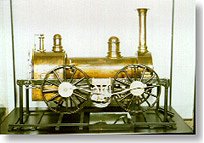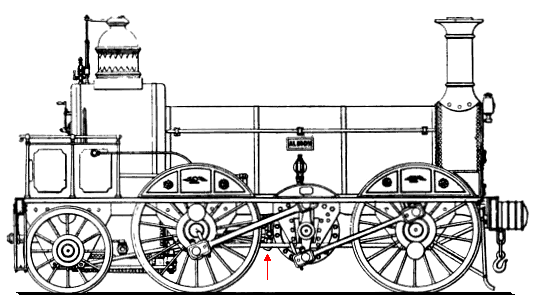Gallery opened: 17 Apr 2008
Updated: 4 Mar 2014 |   
|
A vibratory steam engine has vane pistons very like those of a rotary engine, but they oscillate back and forth rather than turning steadily; this was called the Cambrian sysytem. A connecting rod and crank will therefore be required to get rotary motion, with all the disadvantages of reciprocating masses that need balancing. The sealing problems are at least as severe as for the rotary engines.
The best-known vibratory steam locomotive built in Britain was the "Albion", an 0-4-2 built in 1848, for the South Yorkshire Railway. It appears that three tank-engines were built on the same basic system but details are scarce.
 | Left: A model vibratory steam locomotive.This is a demonstration model of an 0-4-0 based on the 1841 patent of John Jones, of Bristol, England. It is said to use the Cambrian drive system but is evidently not a replica of the Albion, as it has no trailing wheels. This model is in the Rahmi M Koc (?) museum in Istanbul, Turkey. How it got there is anybody's guess. |
The Mechanics' Magazine said:
"For locomotive purposes it offers the great advantage of a direct transmission of the steam power from the piston shaft to the crank or axle of the driving wheel, by means of a single rod without couplings, and with a much less angle of connexion than is common with the engines now in use."
Which makes very little sense to me, unless it is a reference to the old fallacy that power was somehow wasted if the connecting rod and crank were not at right angles.
 | Left: The "Albion" vibratory 0-4-2
This is the "Albion", built by Thwaites Bros of the Vulcan Foundry in Bradford in 1848, for the South Yorkshire Railway. It is supposed to have run there for some 15 years, which would seem to indicate it was successful, though I strongly suspect it might have been converted to a conventional layout during that time.
The transverse cylinder was fitted with "vibrating vane pistons" inside the drum between the two large wheels; these oscillated the central shaft. There appears to be conventional Stephenson valvegear just to the left of the central shaft. (arrowed)
|
Dimensions of the Albion:
Leading and driving wheels: 5ft 6in diameter
Trailing wheels: 3ft 9in diameter
Wheelbase, leading to driving: 9ft 6in
Wheelbase, driving to trailing: 5ft 8in
Throw of driving cranks: 20in
Boiler: 12ft long with 149 tubes
It was claimed by Jones that the arrangement gave perfect balance of the working parts, less wear and tear, fewer working parts, and a lower centre of gravity. (which was a great preoccupation of locomotive designers at the time) In particular, the vane system was supposed to give the angular advantages of a long-stroke crank with out the high piston-speed of a long conventional cylinder.
The Albion made its first run in June 1848, on an 18-mile stretch betwen Bradford and Skipton. It is reported in The Evolution of The Steam Locomotive that "The speed attained and the low fuel consumption are stated to have more than satisfied the builders and others concerned." The Albion was later tried on the Midland railway between Derby and Birmingham, it being claimed that the coke consumption (coal was not used in those days) was 5 pounds per mile less than that of ordinary locomotives. Given the likelihood of steam-leakage past the oscillating vanes, I beg leave to doubt this. The Albion was eventually taken over by the Manchester, Sheffield and Lincolnshire Railway, and after that it disappears into the mists of history.
According to a Mr H Crossley, who appears to have part-owned the intellectual property of the Cambrian system, it "...has, by its invariable performances during the last two years and a half, given the utmost satisfaction." (From Mechanics Magazine Saturday June 1st, 1844)
It is possible, of course, that he was not completely impartial in the matter.
This locomotive was one of those featured in a well-known article "Curiosities of Locomotive Design" which was part of "The Development of the Locomotive Engine", by Angus Sinclair, in Railway and Locomotive Engineering for September-December, 1907. It seems very likely that this engine was built under the Cambrian patent, and this is now confirmed by the diary of David Joy, inventor of the Joy valve-gear.
The extract below is from The Diaries of David Joy, edited by G A Sekon, and published in Railway Magazine in 1908. (Volumes 22 & 23) The originals are held by the Science Museum.
May 1847
"We were asked at Railway Foundry to build this engine, and I got out a set of drawings for her, but when we got to the details of the vibrating pistons in their cylinders, the packings for these showed very slight chance of being made steam-tight, and E B Wilson & Co gave it up after I had worked out the question to exhaustion, and the manufacture was taken up by Messrs. Thwaites Bros, of Bradford. It was patented by John Jones, of Bristol, and called the "Cambrian" system."

THE LABLACHE LOCOMOTIVE
This locomotive previously exhibited here was not a vibratory-piston design, so it has been moved to the Lever-Driven Locomotive gallery.

   
|